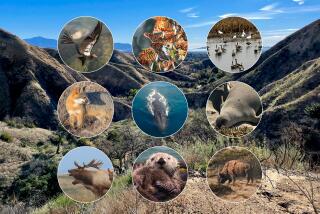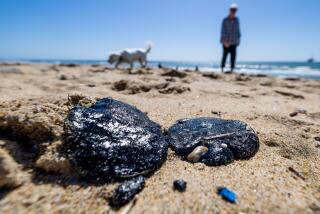WET & WILD : Divers Find Depth of Sea’s Beauty
The scene looks eerily beautiful at 100 feet beneath the surface.
The four stilts of Oil Platform Ellen, breaking the monotony of the Pacific Ocean like the long spindly legs of some huge exotic seafaring spider, plunge relentlessly through the depths.
I am hanging somewhere in the middle, resting on one of many horizontal crossbeams in between, floating dreamily in blue-green space and enjoying the view.
I am here ostensibly to research a story on the harvesting of mussels from the stilts of this oil-pumping platform seven miles off Huntington Beach. A photographer and I arose early this morning to catch the Shell Oil Co. boat in Long Beach Harbor to bring us here. Now, 50 feet above me, I can see the silent white flashes reverberating off the huge vertical beams as he photographs the commercial divers scraping off the black mussels.
I have dropped below the other divers to get a larger perspective, and as I look around, I am struck by the richness of the marine forest in which I float.
Besides the mussels, the thick vertical and diagonal beams are covered by heavy blankets of pink strawberry anemones, mixed with rock scallops and brittle stars. Nearby swims a variety of fish, including opaleye, kelp bass, cabezon and yellowtail. And everywhere, a sense of lushness pervades--an image of nature thriving wildly amid mechanical human contrivance.
“They are similar to an island with a fairly steep shelf,” said Bob Meek, a marine biologist who harvests mussels off oil platforms from Santa Barbara to Huntington Beach. “They are like vertical artificial reefs with huge (sunlit) zones; you just don’t see this density of life” in many other places.
Diving under oil platforms, however, presents a variety of problems.
For one thing, experts say, it is definitely an advanced dive, to be undertaken only by those experienced enough to comfortably regulate their buoyancy. Because of the depth involved, they say, it is easy for an inexperienced diver to inadvertently sink too deep.
The other matter is that, despite the fact that divers in private boats have been exploring beneath the platforms for years, today most oil companies discourage such visits as unnecessary intrusions into their working terrain. However, some platform workers have reacted with a level of hostility that their employers don’t condone.
“I’ve had them squirt me with a fire hose,” said Tom Murray, the owner of Pacific Sporting Goods dive shop in Long Beach who has been diving near various platforms for more than a decade. “One guy dropped a steel plate from 10 stories high that landed 10 feet from my head.”
Oil company officials condemn such behavior and say that if it’s brought to their attention, they will take steps to make sure it doesn’t happen again. But they also suggest that, rather than go it alone, divers interested in exploring a platform do so with a group--preferably a dive club or charter organization--that has secured the permission of the company involved.
One charter firm with such permission is Pacific Diving Adventures of Santa Barbara, which regularly runs a small boat out to the Chevron Oil platforms off Summerland and Carpinteria.
“It’s probably the best diving in California outside the kelp beds,” said Janice Daily, the company’s managing operator. “The colors and the amount of life down there are phenomenal.”
For $50, she said, a diver can spend half a day (either morning or afternoon) exploring the platforms during two dives.
Regarding the hostile oil workers, Daily says they’ve never been a problem on her dives.
“They threaten us with great bodily harm if we don’t bring them back a big bag of scallops,” she quipped. For more information, call the company at (805) 962-1771.


